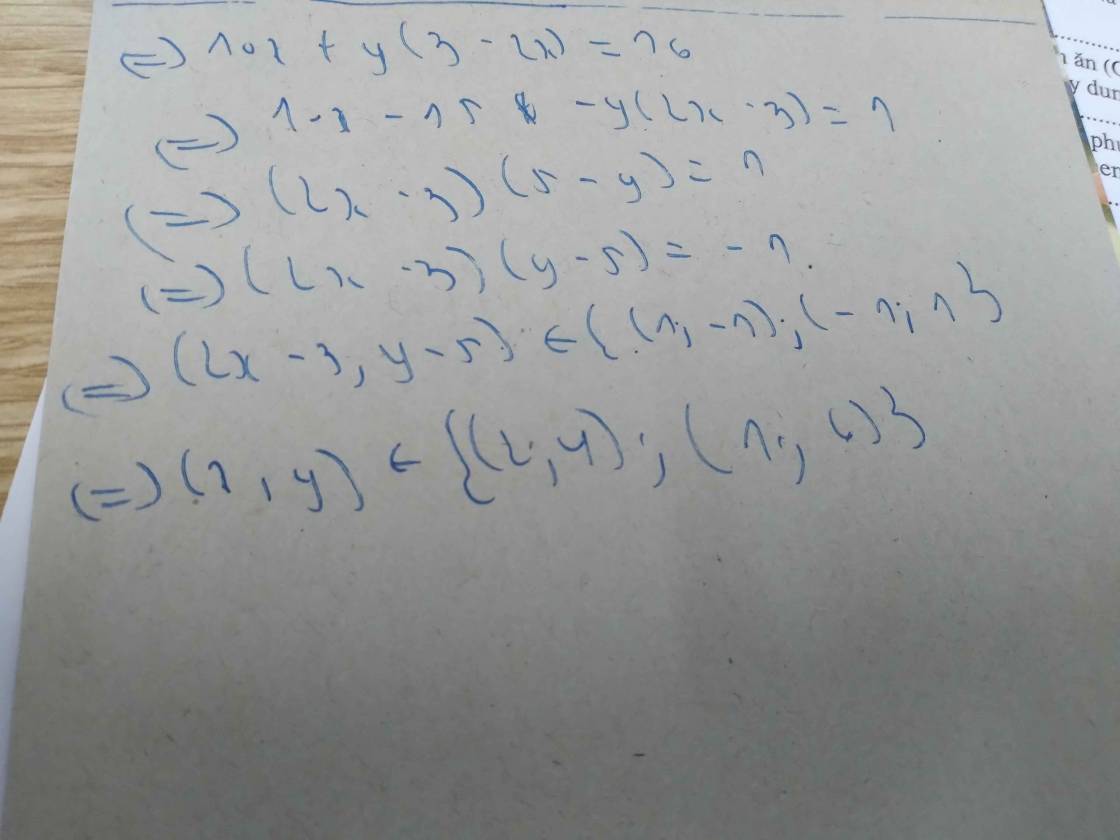
Hãy nhập câu hỏi của bạn vào đây, nếu là tài khoản VIP, bạn sẽ được ưu tiên trả lời.


=>3y(2x+1)-10x-5=7
=>(2x+1)(3y-5)=7
=>\(\left(2x+1;3y-5\right)\in\left\{\left(1;7\right);\left(7;1\right)\right\}\)(Vì x,y là số nguyên)
=>\(\left(x,y\right)\in\left\{\left(0;6\right);\left(3;2\right)\right\}\)

6xy-3y-4x=4
3y.(2x-1)-2.(2x-1)=6
(2x-1).(3y-2)=6
vì x,y là số nguyên nên ta có : x=-1,y=3

pt <=> 3y(2x + 1) - 4x - 2 = -55
<=> 3y(2x + 1) - 2(2x + 1) = -55
<=> (3y - 2)(2x + 1) = -55 = (-1).55 = 55.(-1) = (-5).11 = 11.(-5)
= (-55).1 = 1.(-55) = (-11).5 = 5.(-11)
Thay (3y - 2) và (2x + 1) vào 8 trường hợp trên là tìm được x,y
tất nhiên phải xét xem x,y có là số nguyên hay không

\(6xy-10x+3y=12\)
\(\Leftrightarrow6xy+3y-10x-5=7\)
\(\Rightarrow3y\left(2x+1\right)-5\left(2x+1\right)=7\)
\(\Leftrightarrow\left(2x+1\right)\left(3y-5\right)=7\)
Ta có bảng:
| 2x+1 | -7 | -1 | 1 | 7 |
| 3y-5 | -1 | -7 | 7 | 1 |
| x | -4 | -1 | 0 | 3 |
| y | 4/3 (loại) | -2/3 (loại) | 4 | 2 |
Vậy \(\left(x;y\right)=\left(0;4\right);\left(3;2\right)\)

xy+x-3y=0
=> (xy+x)-3y-3=0-3
=>x(y+1)-(3y+3)=(-3)
=>x(y+1)-3(y+1)=(-3)
=>(y+1).(x-3)=(-3)
Mà (-3)=1.(-3)=(-1).3
Lập bảng giá trị:
| x-3 | 1 | -1 | 3 | -3 |
| y+1 | -3 | 3 | -1 | 1 |
| x | 4 | 2 | 6 | 0 |
| y | -4 | 2 | -2 | 0 |
Vậy các cặp số nguyên (x;y) là (4;-4);(2;2);(6;-2);(0;0)

Ta có: \(6xy-8x-3y-2=0\)
\(\Leftrightarrow6xy-3y-8x+4-6=0\)
\(\Leftrightarrow3y\left(2x-1\right)-4\left(2x-1\right)=6\)
\(\Leftrightarrow\left(2x-1\right)\left(3y-4\right)=6\)
\(\Leftrightarrow\left(2x-1\right);\left(3y-4\right)\inƯ\left(6\right)\)
\(\Leftrightarrow\left(2x-1\right)\left(3y-4\right)\in\left\{1;-1;2;-2;3;-3;6;-6\right\}\)
mà 2x-1 lẻ và \(2x-1\ge-1\) \(\forall x\in N\)
nên \(\left(2x-1\right)\in\left\{-1;1;-3;3\right\}\) và \(\left(3y-4\right)\in\left\{2;-2;6;-6\right\}\)
Trường hợp 1:
\(\left\{{}\begin{matrix}2x-1=-1\\3y-4=-6\end{matrix}\right.\Leftrightarrow\left\{{}\begin{matrix}2x=0\\3y=-2\end{matrix}\right.\Leftrightarrow\left\{{}\begin{matrix}x=0\\y=-\dfrac{2}{3}\left(loại\right)\end{matrix}\right.\)
Trường hợp 2:
\(\left\{{}\begin{matrix}2x-1=1\\3y-4=6\end{matrix}\right.\Leftrightarrow\left\{{}\begin{matrix}2x=2\\3y=10\end{matrix}\right.\Leftrightarrow\left\{{}\begin{matrix}x=1\\y=\dfrac{10}{3}\left(loại\right)\end{matrix}\right.\)
Trường hợp 3:
\(\left\{{}\begin{matrix}2x-1=-3\\3y-4=-2\end{matrix}\right.\Leftrightarrow\left\{{}\begin{matrix}2x=-2\\3y=2\end{matrix}\right.\Leftrightarrow\left\{{}\begin{matrix}x=-1\\y=\dfrac{2}{3}\left(loại\right)\end{matrix}\right.\)
Trường hợp 4:
\(\left\{{}\begin{matrix}2x-1=3\\3y-4=2\end{matrix}\right.\Leftrightarrow\left\{{}\begin{matrix}2x=4\\3y=6\end{matrix}\right.\Leftrightarrow\left\{{}\begin{matrix}x=2\\y=2\left(nhận\right)\end{matrix}\right.\)
Vậy: (x,y)=(2;2)
